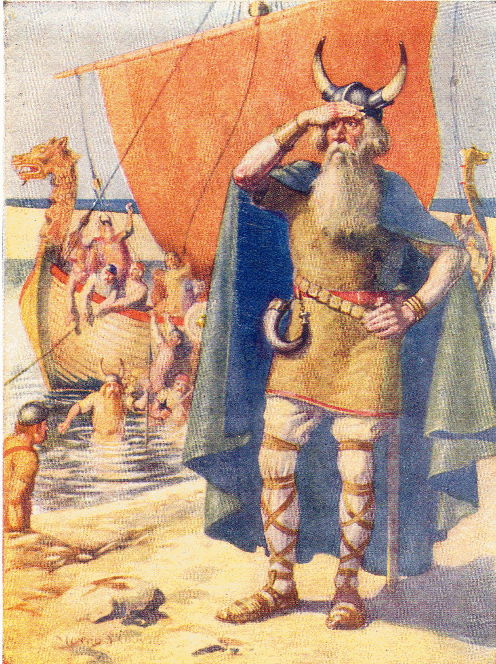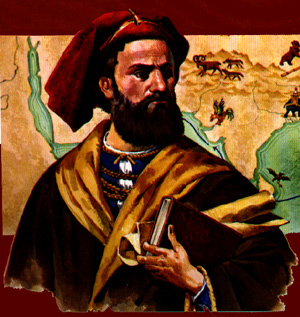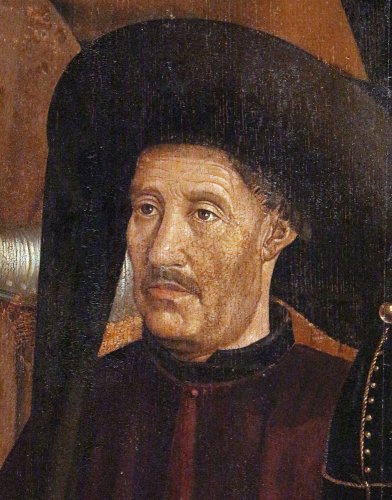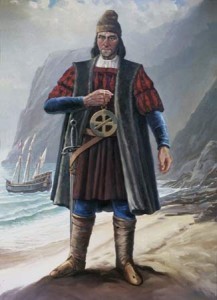Explorers Early Explorers

This map first appeared in Münster's Cosmographia in the 1540s. The map is considered to be the first to show the entire continents of North and South America. Leif Ericson Around the year 982 Eric the Red sailed to Iceland. He landed on the coast of Greenland. He founded the first colony there. His son named Leif Ericson began exploring the area. He reached the North American mainland around the year 1000 and called it Vinland. Later archaeologists uncovered the remains of his settlement at the extreme northern tip of Newfoundland. In 1965 a map dated from around 1440 was found. This Viking map showed parts of northeastern Canada. Marco Polo Marco Polo and his two uncles visited Cathay, later called China. They lived at the court of the Emperor. When he went back to Italy, Polo wrote a book about his travels in the Far East. After the invention of Gutenburg's Printing Press in the year 1436 this book became one of the first to be published. Men became fascinated by Polo's descriptions of the Orient. Men began searching for sea routes to China, Japan, and the East Indies. Some of these men believed that the sea to the east of China and India was the same sea that was west of Europe. One map maker named Paolo Toscanelli even drew a map showing Europe with the Indies to the west rather than the east. Prince Henry Prince Henry spent his entire fortune funding many voyages of exploration as well as projects in navigation, ship design, astronomy, and mapmaking. His expeditions included the islands of the Azores, Madeira, and the Cape Verde Islands, and the African coast as far as present-day Sierra Leone. Bartholomeu Dias King John II , Prince Henry's nephew, continued funding expeditions down the coast of Africa. King John II chose Dias to lead a group close to the southern tip. A storm blew him past the southernmost tip of land. After 13 days Dias was able to turn east, but found no land. He then turned north and sighted the Mossel Bay, around the cape. On his return trip Dias saw the Cape of Good Hope for the first time in May of 1488. Christopher Columbus Christopher Columbus dreamed of becoming a sailor. At age 14 he made his first voyage on an Italian ship. Columbus also read books about the world such as the one written by Marco Polo. Columbus wanted to reach the Indies by sailing west. He tried to raise the money for this expedition in Italy and Portugal, but no one would give him the ships he needed. Finally Columbus went to the king and queen of Spain. They gave him three ships; the Nina, the Pinta, and the Santa Maria, as well as a crew and the money he needed to make the trip. On October 12, 1492 Columbus reached the land. He had not found the Indies. He was really in the Atlantic Ocean. The islands he discovered were off the coast of North America; San Salvador then Cuba which Columbus named Juana. Columbus went back to Spain and showed everyone the gold and other goods he had found. Columbus sailed back to the New World three more times. Amerigo Vespucci Vespucci made voyages to the West Indies and South America for Spain and Portugal. He explored the shores of South America. Some Vespucci reports and maps were found by a German schoolteacher who was writing a geography book. The teacher called the New World America after Vespucci and his voyages. Vasco da Gama King Manuel I of Portugal picked da Gama to head a new expedition that would continue where Dias had stopped. On November 22, 1498 da Gama rounded the Cape of Good Hope. In May he landed at Calicut (now Kozhikode) on the southwest coast of India. da Gama brought back many trade goods from the Indies. Although Da Gama's route was much longer than the earlier trade routes which traveled overland, sea travel was cheaper. He also did not have to worry about bandits stealing the goods. This is why other Portuguese sailors followed Da Gama's route. Soon the Portuguese became masters of the Europe to Indies trade route. Ferdinand Magellan Magellan proved through his explorations that the Earth is round. He established the first route to the East that involved sailing to the west. This passage went around the tip of South America. Magellan sailed for the Spanish king Charles I.







